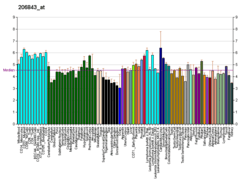Beta-crystallin A4 is a protein that in humans is encoded by the CRYBA4 gene.[5][6][7]
Crystallins are separated into two classes: taxon-specific, or enzyme, and ubiquitous. The latter class constitutes the major proteins of vertebrate eye lens and maintains the transparency and refractive index of the lens. Since lens central fiber cells lose their nuclei during development, these crystallins are made and then retained throughout life, making them extremely stable proteins. Mammalian lens crystallins are divided into alpha, beta, and gamma families; beta and gamma crystallins are also considered as a superfamily. Alpha and beta families are further divided into acidic and basic groups. Seven protein regions exist in crystallins: four homologous motifs, a connecting peptide, and N- and C-terminal extensions. Beta-crystallins, the most heterogeneous, differ by the presence of the C-terminal extension (present in the basic group, none in the acidic group). Beta-crystallins form aggregates of different sizes and are able to self-associate to form dimers or to form heterodimers with other beta-crystallins. This gene, a beta acidic group member, is part of a gene cluster with beta-B1, beta-B2, and beta-B3.[7]
References
- 1 2 3 GRCh38: Ensembl release 89: ENSG00000196431 - Ensembl, May 2017
- 1 2 3 GRCm38: Ensembl release 89: ENSMUSG00000066975 - Ensembl, May 2017
- ↑ "Human PubMed Reference:".
- ↑ "Mouse PubMed Reference:".
- ↑ Lampi KJ, Ma Z, Shih M, Shearer TR, Smith JB, Smith DL, David LL (Feb 1997). "Sequence analysis of betaA3, betaB3, and betaA4 crystallins completes the identification of the major proteins in young human lens". J Biol Chem. 272 (4): 2268–75. doi:10.1074/jbc.272.4.2268. PMID 8999933.
- ↑ Schuschke G, Mielke U, Bodamer S, Rosenkranz M (Oct 1976). "[Feral domestic pigeons as a hygienic problem in big cities--the situation in Magdeburg]". Z Gesamte Hyg. 22 (1): 30–4. PMID 960806.
- 1 2 "Entrez Gene: CRYBA4 crystallin, beta A4".
Further reading
- Billingsley G, Santhiya ST, Paterson AD, et al. (2006). "CRYBA4, a novel human cataract gene, is also involved in microphthalmia". Am. J. Hum. Genet. 79 (4): 702–9. doi:10.1086/507712. PMC 1592554. PMID 16960806.
- Gerhard DS, Wagner L, Feingold EA, et al. (2004). "The status, quality, and expansion of the NIH full-length cDNA project: the Mammalian Gene Collection (MGC)". Genome Res. 14 (10B): 2121–7. doi:10.1101/gr.2596504. PMC 528928. PMID 15489334.
- Collins JE, Wright CL, Edwards CA, et al. (2005). "A genome annotation-driven approach to cloning the human ORFeome". Genome Biol. 5 (10): R84. doi:10.1186/gb-2004-5-10-r84. PMC 545604. PMID 15461802.
- Strausberg RL, Feingold EA, Grouse LH, et al. (2003). "Generation and initial analysis of more than 15,000 full-length human and mouse cDNA sequences". Proc. Natl. Acad. Sci. U.S.A. 99 (26): 16899–903. doi:10.1073/pnas.242603899. PMC 139241. PMID 12477932.
- Mackay DS, Boskovska OB, Knopf HL, et al. (2003). "A nonsense mutation in CRYBB1 associated with autosomal dominant cataract linked to human chromosome 22q". Am. J. Hum. Genet. 71 (5): 1216–21. doi:10.1086/344212. PMC 385100. PMID 12360425.
- MacCoss MJ, McDonald WH, Saraf A, et al. (2002). "Shotgun identification of protein modifications from protein complexes and lens tissue". Proc. Natl. Acad. Sci. U.S.A. 99 (12): 7900–5. doi:10.1073/pnas.122231399. PMC 122992. PMID 12060738.
- Dunham I, Shimizu N, Roe BA, et al. (1999). "The DNA sequence of human chromosome 22". Nature. 402 (6761): 489–95. doi:10.1038/990031. PMID 10591208.
- Bonaldo MF, Lennon G, Soares MB (1997). "Normalization and subtraction: two approaches to facilitate gene discovery". Genome Res. 6 (9): 791–806. doi:10.1101/gr.6.9.791. PMID 8889548.
- David LL, Shearer TR, Shih M (1993). "Sequence analysis of lens beta-crystallins suggests involvement of calpain in cataract formation". J. Biol. Chem. 268 (3): 1937–40. PMID 8420967.
- Bijlsma EK, Delattre O, Juyn JA, et al. (1994). "Regional fine mapping of the beta crystallin genes on chromosome 22 excludes these genes as physically linked markers for neurofibromatosis type 2". Genes Chromosomes Cancer. 8 (2): 112–8. doi:10.1002/gcc.2870080208. PMID 7504514.
- van Rens GL, Geurts van Kessel AH, Bloemendal H (1992). "Localization of the beta A4-crystallin gene (CRYBA4) on human chromosome 22 in the region q11.2→q13.1". Cytogenet. Cell Genet. 61 (3): 180–3. doi:10.1159/000133403. PMID 1424806.




